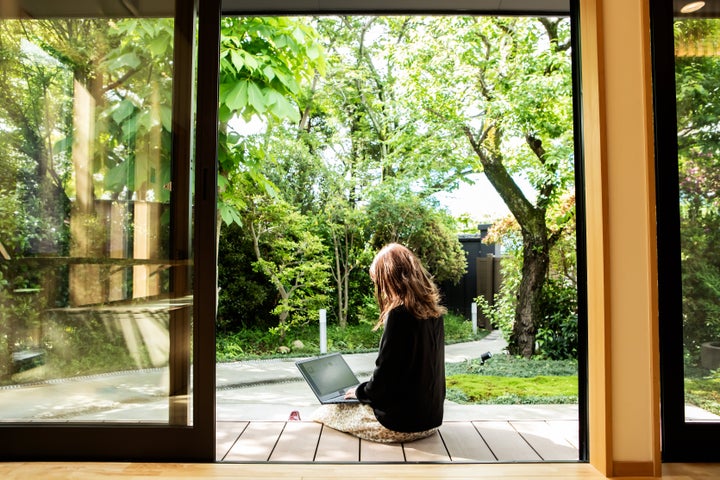
After the onset of the pandemic, many office workers learned something: Being present in one physical workplace is not essential for every job.
Even as offices reopened, countless employees continued to work from home ― or from somewhere else. Not only did this change the way people work, but it also changed the way they travel. Enter the “hush trip.”
But what exactly is a hush trip, and how does it work? Below, experts break down the benefits and downsides of this approach to travel.
What is a ‘hush trip’?
“A ‘hush trip’ is where employees work remotely from a location other than their usual one, without informing their employers,” said travel blogger Sean Lau.
It’s a temporary setup in which employees might simply work from a beach house an hour away from home for a few days ― or they might travel to a different time zone or even internationally.
“Since they can just log on and handle their job duties from anywhere, the mindset is why even bring it up to your employer if you happen to be in the Bahamas while you’re working,” said travel blogger Esther Susag.
Hush-trippers typically continue to do their work tasks and take Zoom meetings, but refrain from mentioning where they are located. They work from hotel rooms, coffee shops and even short-term co-working spaces.
“They may go as far as to use a VPN to disguise their IP address and location,” said Gabby Beckford, a travel expert and founder of travel site Packs Light.
The concept is somewhat similar to “bleisure travel,” which involves combining business and leisure travel. Bleisure travellers might go on a work-related trip, but tack on extra time on the front or backend for vacation. They might also work remotely from their destination in between relaxation and touristy activities.
With hush trips and bleisure travel, employees often take friends or family along, but they might also go solo.
“It’s an experience woven into the fabric of the digital nomad and remote worker lifestyle since the dawn of connectivity,” said Erick Prince, a travel blogger and founder of travel site Minority Nomad. “And now, the broader travel world is having a taste of its charms. But like any dish, this trend comes with its own unique blend of flavours ― both delightful and challenging.”

What are the benefits of this kind of travel?
“As someone who works remotely and prefers working somewhere scenic, I think a hush trip can increase productivity and improve mental well-being, ultimately increasing employee retention,” Lau said.
Proponents of hush trips believe this kind of travel offers a much-needed boost to workers’ morale and quality of life.
“They can avoid the stress of explaining their reasons for travel to their boss and getting corporate approval, and a potential ‘no,’” Beckford said.
Hush trips also allow for a level of spontaneity and flexibility in travel (which allows workers to take advantage of great deals, among other benefits).
“You can just wake up one morning, decide ‘I feel like working with an ocean view this week,’ and can just hop on a flight that afternoon without sending PTO requests ― you’re just embracing that digital nomad lifestyle,” Susag said.
Since 2020, many industries have rethought their approach to work environments. The hush trip fits into that escape from a traditional “desk-bound existence,” Prince noted. There’s a balance of structure and independence.
“It’s a passport to freedom, a chance to roam, explore, and breathe life into both personal and professional endeavours in ways unimaginable within the confines of conventional office culture,” he explained. “It’s about combating the relentless spectre of burnout, reclaiming our right to truly live rather than merely exist in the grind.”
What are the downsides?
“There are risks to hush trips, especially if you are going somewhere with unreliable internet connectivity or significant time zone differences,” Lau noted.
You might run into issues with your employer that could jeopardise your future with the company.
“It shows a lack of trust between employer and employee, and if they were to call that employee into the office at the last minute, there would be issues,” Beckford said.
In addition to the erosion of trust, administrative concerns might also arise, especially if you turn your short-stint hush trip into a more extended stay.
“HR teams already struggle tracking where remote workers are based,” Susag said. “Hush trips make that borderline impossible and open up all sorts of potential tax, privacy and legal issues depending on where folks work from unannounced. So for workers, hush trips epitomise remote work freedom. But for employers, I don’t think they see them the same way.”
Prince echoed this sentiment, pointing to the visa and tax implications, network security hazards and potential disruptions to workflows. But he and other travel pros who spoke to HuffPost expressed that the hush trip lifestyle can be OK as long as employees are delivering their work consistently and on time.
“Certain challenges have prompted many companies to ‘ban’ hush trips,” he said. “But much like the reluctant return to the office post-pandemic, the economics of reverting to the brick-and-mortar grind may prove unpalatable for many.”